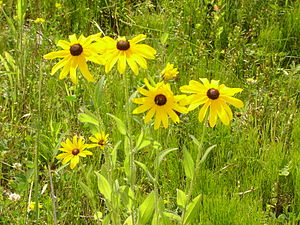Black-eyed Rudbeckia
| Black-eyed Rudbeckia | ||||||||||||
|---|---|---|---|---|---|---|---|---|---|---|---|---|

Black-eyed Rudbeckia ( Rudbeckia hirta ), habit and flower heads |
||||||||||||
| Systematics | ||||||||||||
|
||||||||||||
| Scientific name | ||||||||||||
| Rudbeckia hirta | ||||||||||||
| L. |
The Black-Rudbeckia ( Rudbeckia hirta ), also Rough Sun called, is a species within the genus of Rudbeckia ( Rudbeckia ) in the family of Korbblütengewächse (Asteraceae).
description
Vegetative characteristics
The rough coneflower is a biennial or perennial herbaceous plant and reaches heights of 10 to 50, rarely up to 100 centimeters. The upright, sparsely branched stem is protruding, coarse hairy and loosely leafed.
The leaves are all undivided, long, coarse hairy on both sides, roughly toothed, finely serrated or with entire margins and more or less clearly three-veined. The basal leaves are broadly elliptical to lanceolate and have long stalks. The stem leaves are ovate, lanceolate or oblong spatulate to almost linear; the lower ones are stalked, the middle ones narrowed like stalk and the upper ones seated.
Generative characteristics
The flowering period is between July and September. The flower heads are long stalked and stand individually at the end of the stem or the few side branches. The flower heads have a diameter of 4 to 6 centimeters. The two to three rows arranged bracts are protruding or bent back, about 10 to 15 millimeters long, 2 to 3 millimeters wide and coarsely hairy. The base of the head is hemispherical to conical, it is covered with pointed, linear-lanceolate chaff leaves that are about as long as the tubular flowers . The ray-flowers are orange-yellow with sometimes purple-colored tongue at the base. The tongue is hairy short on the underside. The numerous disc flowers are dark purple to brown-black.
The achenes are square and one pappus is missing.
The number of chromosomes is 2n = 38.
Occurrence
Rudbeckia hirta is distributed in North America from southern Canada to the southeastern USA. It is a neophyte in Europe, China and Cuba . It was often cultivated in Central Europe and has grown wild on grassy roadsides, on wastelands and on banks and is less naturalized.
It thrives in Central Europe on moderately dry to fresh, nutrient-rich, gritty-sandy or pure loam or clay soils in societies of the associations Arction lappae, Onopordion and Dauco-Melilotion or the subclass Galio-Urticenea.
Systematics
Rudbeckia hirta was first published by Carl von Linné . Rudbeckia serotina Nutt is a synonym for Rudbeckia hirta L.
The species Rudbeckia hirta is quite variable and there are several varieties:
- Rudbeckia hirta var. Angustifolia (TVMoore) Perdue : It is distributed in the southern central to eastern US states of Texas , Alabama , Florida , Georgia , Louisiana , Mississippi and South Carolina .
- Rudbeckia hirta var. Floridana (TVMoore) Perdue : It occurs only in Florida.
- Rudbeckia hirta L. var. Hirta
- Rudbeckia hirta var. Pulcherrima Farw. (Syn .: Rudbeckia bicolor Nutt., Rudbeckia hirta var. Corymbifera Fernald): It is widespread from Canada to the USA. Their number of chromosomes is 2n = 38.
use
Some varieties such as 'Becky', 'Irish Eyes', 'Sonora', 'Toto' are used in the temperate areas as ornamental plants in parks and gardens.
Others
The black-eyed rudbeckia is the state flower of Maryland .
literature
- Gerhard Wagenitz : Family Compositae. In Gerhard Wagenitz (Ed.): Illustrated flora of Central Europe. Pteridophyta, Spermatophyta . Founded by Gustav Hegi. 2nd, completely revised edition. Volume VI. Part 3: Angiospermae, Dicotyledones 4 (Compositae 1, General Part, Eupatorium - Achillea) . Paul Parey, Berlin / Hamburg 1979, ISBN 3-489-84020-8 (published in deliveries 1964–1979). (Sections Description and Occurrence)
Individual evidence
- ↑ a b Rudbeckia hirta at Tropicos.org. In: IPCN Chromosome Reports . Missouri Botanical Garden, St. Louis
- ↑ a b Erich Oberdorfer : Plant-sociological excursion flora for Germany and neighboring areas . With the collaboration of Angelika Schwabe and Theo Müller. 8th, heavily revised and expanded edition. Eugen Ulmer, Stuttgart (Hohenheim) 2001, ISBN 3-8001-3131-5 , pp. 926 .
- ↑ a b c d Rudbeckia hirta in the Germplasm Resources Information Network (GRIN), USDA , ARS , National Genetic Resources Program. National Germplasm Resources Laboratory, Beltsville, Maryland. Retrieved April 28, 2016.
- ↑ Walter Erhardt , Erich Götz, Nils Bödeker, Siegmund Seybold: The great zander. Encyclopedia of Plant Names. Volume 2. Types and varieties. Eugen Ulmer, Stuttgart (Hohenheim) 2008, ISBN 978-3-8001-5406-7 . P. 1707.
Web links
- Rudbeckia hirta L., wire-haired rudbeckia. In: FloraWeb.de.
- Black-eyed Rudbeckia . In: BiolFlor, the database of biological-ecological characteristics of the flora of Germany.
- Profile and distribution map for Bavaria . In: Botanical Information Hub of Bavaria .
- Rudbeckia hirta L. In: Info Flora , the national data and information center for Swiss flora . Retrieved April 28, 2016.
- Thomas Meyer: Sun hat data sheet with identification key and photos at Flora-de: Flora von Deutschland (old name of the website: Flowers in Swabia ).






